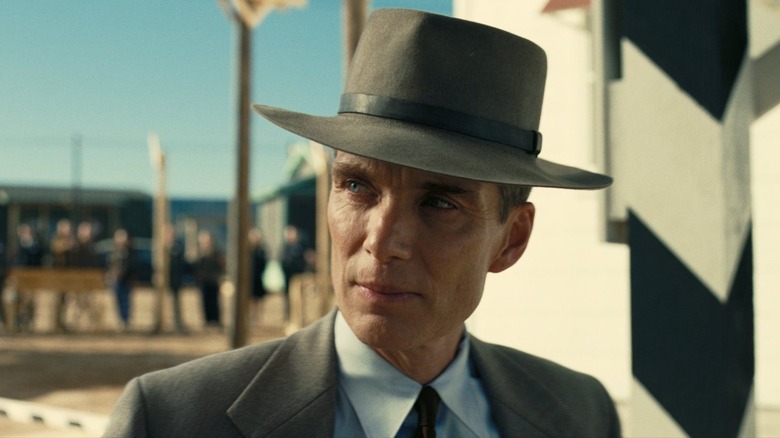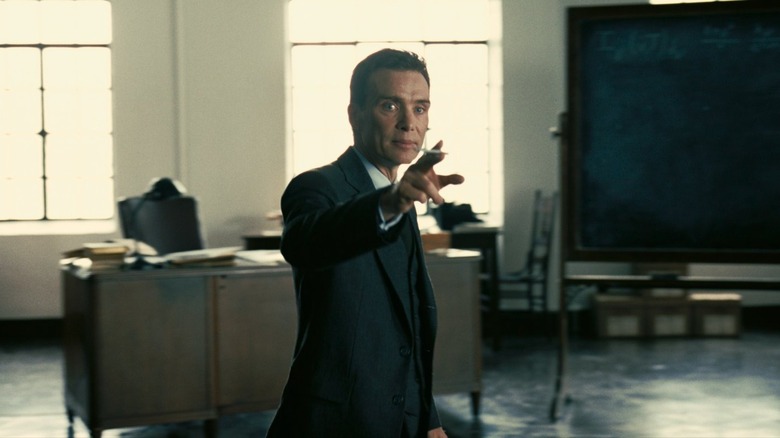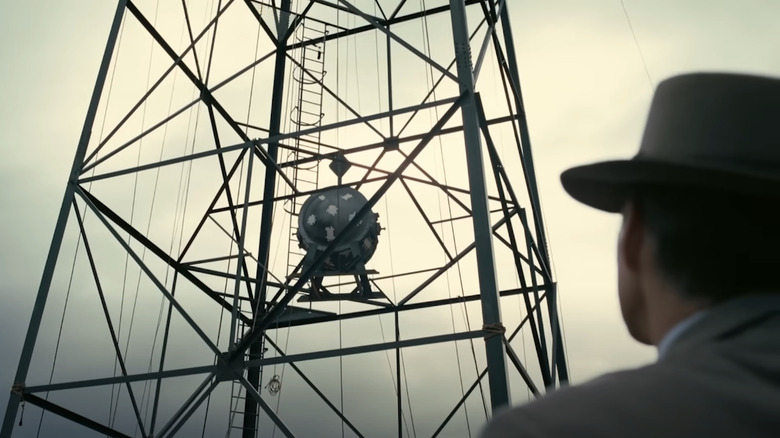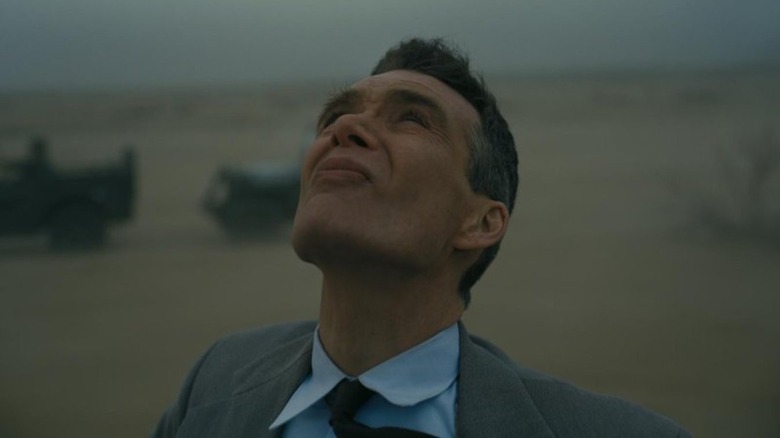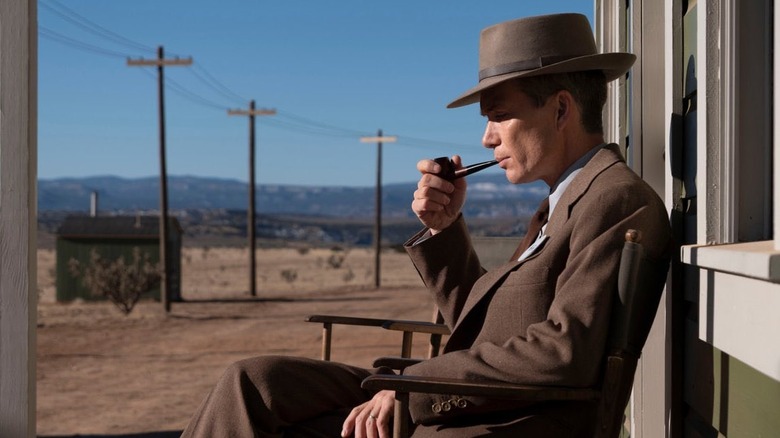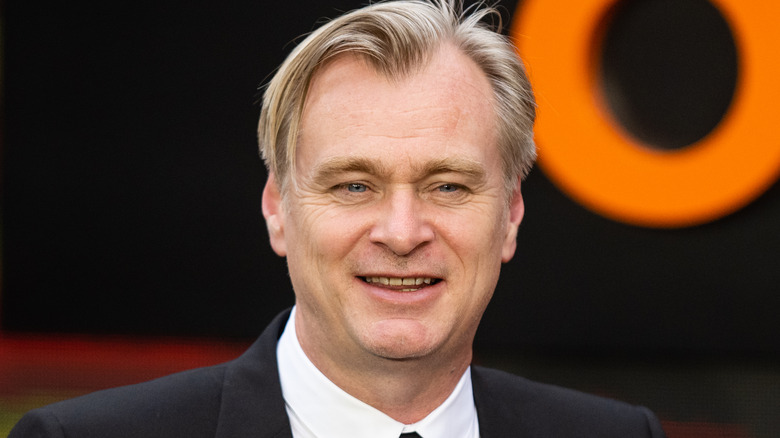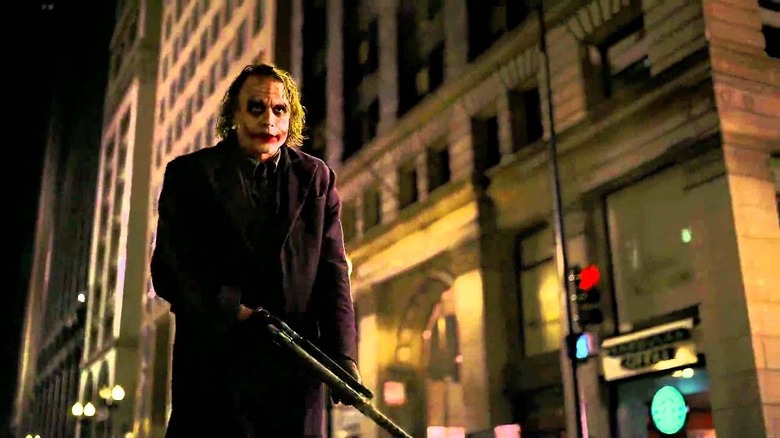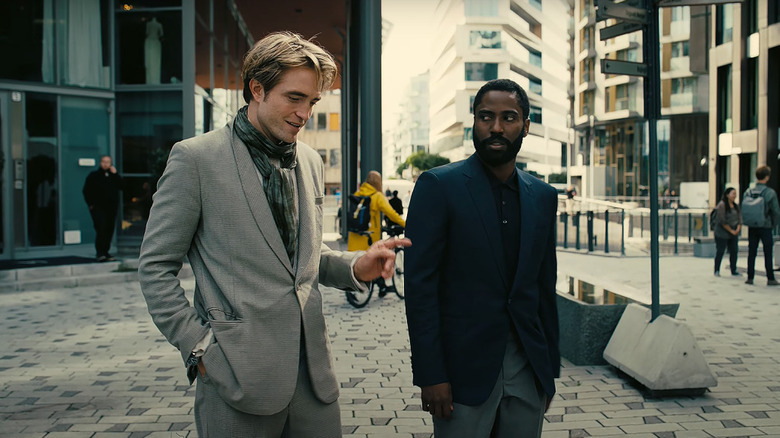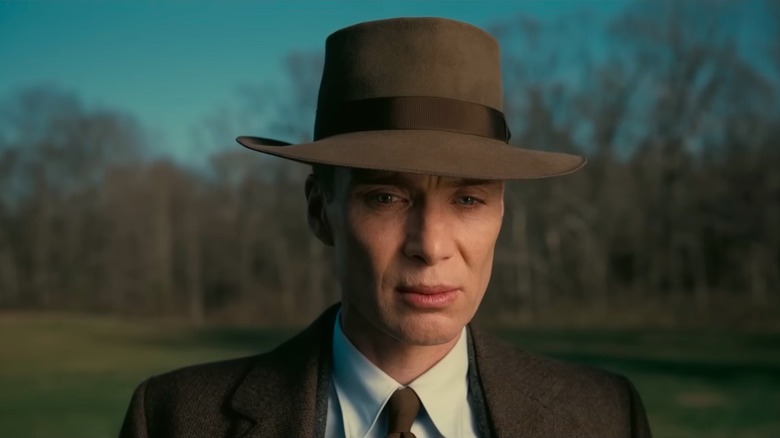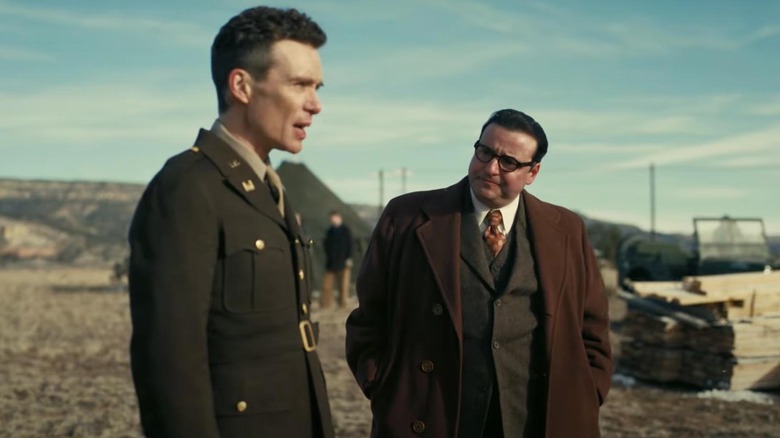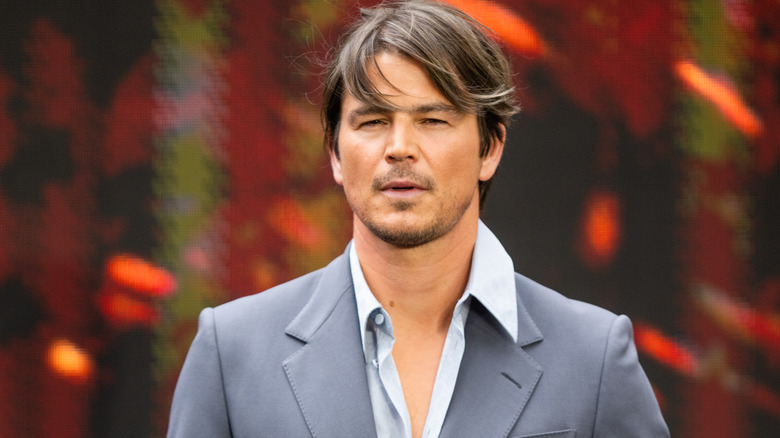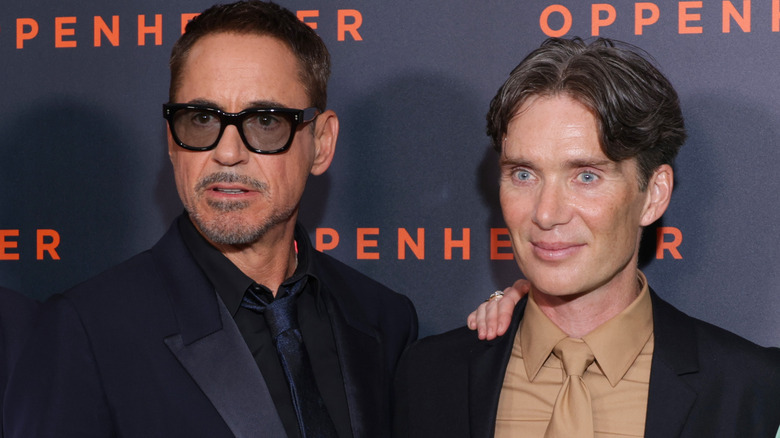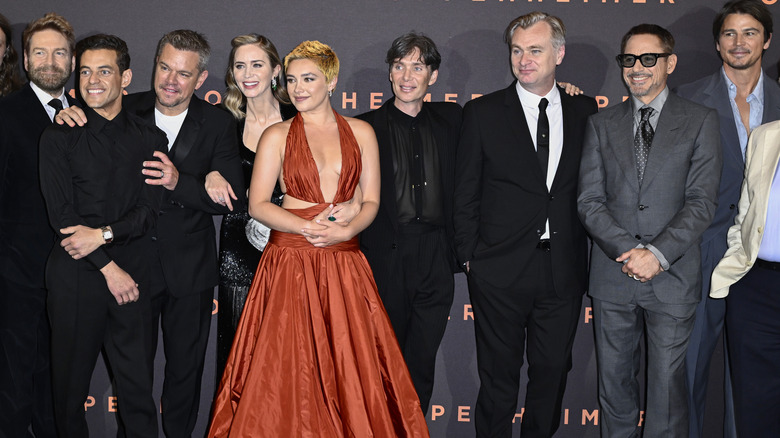The Untold Truth Of Christopher Nolan's Oppenheimer
Christopher Nolan broke out in 2000 with "Memento," and helped reboot the Caped Crusader in 2005 with "Batman Begins." He's the rare director who's arguably never made a bad movie, and audiences know that a ticket to a Nolan film will deliver heart-stopping suspense, stirring performances, and plenty of captivating drama. His 2023 effort, "Oppenheimer," however, is unlike any film he's ever made: A biopic centered on the man who invented the first atomic bomb.
Led by Cillian Murphy in the title role, the film's all-star cast includes the likes of Robert Downey Jr., Matt Damon, Florence Pugh, and Emily Blunt. The film has left critics stunned, with Lindsey Bahr of the Associated Press dubbing it "a spectacular achievement in its truthful, concise adaptation," and it was no easy feat to assemble. It may in fact be Nolan's most epic film yet, but if you think you knew everything about it, think again. From the ins and outs of filming the movie's most jaw-dropping scenes to problems between the actors on set, this is the untold truth of Christopher Nolan's "Oppenheimer."
The film features no computer generated effects
From superhero blockbusters to intimate dramas, it seems like every movie has at least some CGI these days. Whether depicting elements that can't exist in the real world or enhancing big stunts like in the "Mission: Impossible" films, even movies made with practical effects use CGI to get things just right. But Christopher Nolan wanted everything in "Oppenheimer" to be filmed in camera, without the use of any computer-generated shots at all.
"There are no CGI shots in the movie," Nolan told Collider while doing press for the film ahead of its release. "I think computer graphics, they're very versatile, they can do all kinds of things, but they tend to feel a bit safe," he explained. "That's why they're difficult to use in horror movies. Animation tends to feel a little safe for the audience."
Knowing that safe often meant sanitizing, the director wanted to eliminate CGI in an effort to ensure the frightening nature of atomic discovery was felt with the proper weight. "The Trinity Test, ultimately, but also these early imaginings of Oppenheimer visualizing the quantum realm, they had to be threatening in some way. They had to have the bite of real-world imagery. The Trinity Test, for those who were there, was the most beautiful and terrifying thing simultaneously, and that's where we were headed with this film."
No, they didn't drop a real nuclear bomb
With director Christopher Nolan's insistence on zero CGI, it's fair to wonder how the film was able to capture the test detonation of the first nuclear device in what was known as the "Trinity Test." But contrary to much speculation, Nolan didn't actually film the dropping of a real nuclear bomb, though he did manage to recreate its effects with state-of-the-art pyrotechnic technology.
In an interview with Total Film (via SyFy), Nolan talked about how they filmed the climactic test of the first nuclear device called Trinity, discussing how they used forced perspective to turn an otherwise ordinary explosion into a nuclear one. "We don't call them miniatures; we call them 'big-atures,'" Nolan said. "We do them as big as we possibly can, but we do reduce the scale so it's manageable. It's getting it closer to the camera, and doing it as big as you can in the environment."
Though they didn't use a real nuke or CGI, what they did use was a massive amount of gasoline and propane. Additional quantities of aluminum powder and magnesium were also used to create the brilliant flash of light that accompanies a nuclear detonation, which was key to the effect. "We really wanted everyone to talk about that flash, that brightness. So we tried to replicate that as much as we could."
Production lucked out with a well-timed storm
Shooting the Trinity Test was more complicated than just explosives and big miniatures, especially since they shot on location in the harsh New Mexico desert. Nolan and star Cillian Murphy spoke with the Associated Press about what filming the sequence was like. According to Nolan, it was "mostly nights out in the desert under some extraordinary conditions." But they weren't faced with just the ordinary weather elements that would accompany any outdoor shoot, and the pair talked about how a lucky storm helped recreate the iconic moment in much the same way that it happened in real life.
"The weather kind of did what it needed to do as per what happened in history, which is kind of amazing," Murphy explained. "It only happens on his films, it was kind of amazing, and it kind of felt very powerful," Murphy said, gesturing to Nolan. "I'm rumored to be very lucky with the weather," Nolan acknowledged slyly. "It was essential to the story that this big storm rolls in with tremendous drama, and it did and it really made the sequence come to life."
But the well-timed weather didn't just help the movie look good — it helped the actors' performances, too. "Everything is practical and real so you are experiencing it as the character would," Murphy said. "Hopefully the reactions are as natural and as instinctual as you would hope. We all felt it."
Cillian Murphy lost an unhealthy amount of weight to play the title role
Christopher Nolan is no stranger to working with actors who will physically transform themselves for a role. Still, he probably didn't expect to see his "Oppenheimer" star Cillian Murphy make the kind of radical body changes he did for the role — after all, the renowned physicist wasn't any kind of superhero. But Nolan was surprised when he learned that Murphy had dropped an unhealthy amount of weight for the role to better embody J. Robert Oppenheimer physically.
Murphy really wanted to capture the likeness of the famed Oppenheimer, who was known for his thin frame. "[He] had a very distinct physicality and silhouette, which I wanted to get right. I had to lose quite a bit of weight," he said in an interview with The New York Times. "He was very slim, almost emaciated, existed on martinis and cigarettes."
To achieve the look, Murphy put himself to the test, often refusing to eat at all. "You become competitive with yourself a little bit which is not healthy," Murphy told The Guardian. "I don't advise it." The all-consuming aspect of the production helped, too. "I was running on crazy energy," he said in an interview with IndieWire. "I went over a threshold to where I was not worrying about food or anything. I was so in it, a state of hyper something. But it was good because the character was like that. He never ate."
How COVID-19 made the movie possible
Ever since "Batman Begins," Christopher Nolan has been one of the hottest directors in Hollywood. And Warner Bros. seemed to be his exclusive studio, producing every movie after the Batman trilogy, including "The Prestige," "Interstellar," and "Dunkirk." But in 2020, amid the Covid-19 pandemic, his then-upcoming sci-fi thriller "Tenet" was repeatedly pushed back. While Nolan was supportive of the delays to ensure a true cinematic experience for his film, the studio then did the unthinkable: In December 2020, they announced that all of their 2021 films would be released day-and-date on streaming, including several of its blockbuster titles.
While "Tenet" wasn't affected, Nolan was alarmed by the move, and vocal in his opposition to the decision, calling it a "bait and switch" move. "In 2021, they've got some of the top filmmakers in the world, they've got some of the biggest stars in the world who worked for years in some cases on these projects very close to their hearts that are meant to be big-screen experiences," Nolan told Entertainment Tonight. "And now they're being used as a loss-leader for the streaming service — for the fledgling streaming service — without any consultation."
As a result, he swore off the studio, and in September 2021, he inked a deal with Universal for his next movie, the first without Warner Bros. in almost 20 years. Universal gave him an unprecedented deal, agreeing to every ask the director wanted, including an exclusive theatrical window. And the first film he decided to make was "Oppenheimer," a film on a scale that practically begs to be seen in theaters.
How the Dark Knight influenced Oppenheimer
To make "Oppenheimer," Christopher Nolan didn't just look to history, but also to lessons he learned in his earlier productions. And perhaps surprisingly, it was an experience during the filming of "The Dark Knight" that gave him the inspiration and experience with effects to create the incredible Trinity Test sequence. "I think I've done a lot of large-scale practical effects, they come together on 'Oppenheimer' in the Trinity Test which we knew had to be a showstopper," he said in a chat with Jake's Takes while doing promotion for the film. "I think that the single most influential for me was that truck flip [in "The Dark Knight"]," Nolan revealed.
Though the two sequences are vastly different, with very little in common story-wise (after all, one takes place within a comic book universe, the other in WWII-era New Mexico), the one thing they do share is the fact that nobody thought they could be pulled off without significant CGI help. "At first everybody felt that it was too difficult and too complicated to do for real." But after mulling it over with his carefully selected team of effects people, the skepticism faded. "I learned that if you challenge people and you come to them earlier — and said to them right from the beginning, 'let's show the first atomic bomb without using computer graphics. Let's find real ways to photograph this so the audience can get that particularly hypnotic and dangerous feeling that you would have had watching the first example of nuclear fire that had ever been unleashed."
The movie came about thanks to a gift from a Batman
Christopher Nolan has a knack for coming up with clever ideas for his movies, whether it's the intricate murder mystery told backward in "Memento" or the story of a dream thief in "Inception." For "Oppenheimer," he decided to make his first nonfiction movie, but this time the idea to make actually originated from a gift given to him by his "Tenet" star Robert Pattinson. When the film wrapped, it was a book of Oppenheimer speeches Pattinson presented him with that got his mind working.
"You're reading these great intellects trying to deal with the massive consequences of the way in which they've changed life forever for all of us," he told journalist Tara Hitchcock. "And I really got hooked on the story." From there, Nolan began digging further, which led him to the book "American Prometheus," by Kai Bird and Martin J. Sherwin, which tells the story of Oppenheimer's life. Nolan used this as the foundation for his film, and even got its authors involved.
"I ultimately collaborated with Kai and Martin, I had their 700 pages," he told the Los Angeles Times. "That meant my draft was going to be a shooting draft, which is not the case when I am throwing ideas around with my brother [frequent co-writer Jonathan Nolan], and anything is possible."
Cillian Murphy's hat was custom made for the movie
In a biopic like "Oppenheimer," authenticity is key, particularly as a period piece that takes place nearly 80 years ago. That means period-specific sets, props, and wardrobe, and with the famously meticulous Christopher Nolan in the director's chair, you know special attention is going to be given to these details. Well, when it came to capturing the look of Oppenheimer himself, that meant more than having Cillian Murphy lose weight, but also recreating his uniquely identifiable "porkpie" hat that he wore everywhere, which shows up in a number of iconic portraits.
Unfortunately for Nolan and his crew, this hat wasn't something that could simply be purchased off the shelf, or even loaned out from a Hollywood prop house. In fact, getting the right hat proved so troublesome that the filmmaker opted to have the accessory custom-made just for the film. "It was very difficult to build it," Nolan revealed to the Los Angeles Times. "The brim can't be too stiff or too floppy. It's like artfully disheveled hair — it takes a lot of fussing, and I often fussed with the hat just before a take."
Nolan refused to create composite characters
When it comes to a biopic as monumental as "Oppenheimer," it's bound to include a large number of characters. To that end, many filmmakers have taken to creating composite characters, blending together multiple real-life figures to cut down on the number of cast members needed and streamline the story. Such was the case in Aaron Sorkin's "Moneyball," for example, where to tell the tale of baseball guru Billy Beane, the character of Peter Brand (played by Jonah Hill, who was nominated for an Oscar for his performance) was invented for the film, combining several real-life people into one character.
For "Oppenheimer," though, Christopher Nolan ultimately decided that the film would not remove any of the real-life figures from the true story or create such composite characters. He wanted the film to be as accurate and true-to-life as possible, and that's why the film has such an expansive ensemble cast that includes the likes of Matt Damon, Robert Downey Jr., Josh Hartnett, Emily Blunt, Jack Quaid, Rami Malek, Casey Affleck, Dane DeHaan, and Florence Pugh.
With such a wide-ranging ensemble, the film becomes all the more layered and complex. "Because they are playing real people, the actors come in with their own understanding of the characters," Nolan told the Los Angeles Times. "They're bringing their own vision, and the film becomes so much richer."
Oppenheimer is catharsis for Josh Hartnett
There was a time in the early 2000s when actor Josh Hartnett was one of the hottest up-and-coming stars in Hollywood. In addition to starring alongside Ben Affleck and Kate Beckinsale in Michael Bay's "Pearl Harbor," he was in a modern-day retelling of "Othello" and the war movie "Black Hawk Down." Though he had his share of struggles — including the disastrous Harrison Ford cop comedy "Hollywood Homicide" — he was still something of a hot name when Christopher Nolan started work on "Batman Begins."
Before Christian Bale entered the picture, Hartnett was offered the lead role, but ultimately declined, afraid that a superhero movie could hurt his burgeoning career in the days before the genre had really hit it big. Well, Nolan was reportedly miffed at Hartnett passing on the offer, and the actor realized too late that it might have been a bad move. "I've definitely said no to some of the wrong people," the actor told Playboy (via /Film). "I learned my lesson when [writer-director] Christopher Nolan and I talked about 'Batman.' I decided it wasn't for me. Then he didn't want to put me in 'The Prestige.' They not only hired their Batman for it, they also hired my girlfriend at the time."
While Nolan went on to become the biggest director around, and often cast actors over and over — like Michael Caine, Gary Oldman, and Christian Bale — Hartnett never got a second chance. Until now, that is.
Robert Downey Jr. was intimidated by Cillian Murphy
There have been plenty of instances of actors being apprehensive or even scared around their on-screen co-stars. Of all the actors to be intimidated, though, you probably wouldn't expect the great Robert Downey Jr. to be one of them. After all, the A-list star is one of the most powerful, well-paid, and respected stars in Hollywood these days, who helped build one of the most influential film series of the 21st century. But according to the man himself, he really was put on edge by one of his co-stars: leading man Cillian Murphy.
In the film, Downey Jr. plays Lewis Strauss, an antagonist to J. Robert Oppenheimer who fought against the famous physicist's security clearance in a controversial government hearing while serving as chair of the U.S. Atomic Energy Commission in the 1950s. "Even just by the time I was on set, seeing how Cillian had embodied this character. To the point where you go like, 'I'm practically with the guy.' You can't help but feel a little bit iced out by it." Robert told ExtraTV, "Now Cillian is so warm and nice and inviting. But then we'd roll, and I'd feel like he was looking through me like I didn't exist."
The cast lived together during production
With one of the most sprawling A-list casts ever assembled for a single film, "Oppenheimer" is like few biopics ever made. With so much talent together in one place, you might think there would have been a clash of egos, but from all accounts that doesn't appear to have been the case. In fact, during the production of the film, when they were all assembled in New Mexico for location shooting, most of the cast actually lived together. All cooped up together, actress Emily Blunt described the experience as being like a "summer camp" while speaking to People Magazine.
"We were all in the same hotel in the middle of the New Mexican desert," Blunt reminisced. "We only had each other. Me and Matt [Damon] were roommates and we were like, 'Let's go to have dinner.'" There was one notable exception to the cast get-togethers, and that was the movie's principal star, Cillian Murphy. "The sheer volume of what he had to take on and shoulder is so monumental," recalled Blunt. "Of course he didn't want to come and have dinner with us." Damon echoed Blunt's sentiment, saying, "He couldn't. His brain was just too full."
